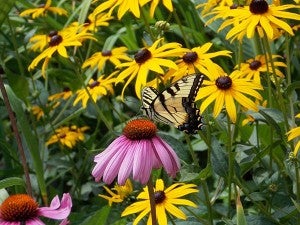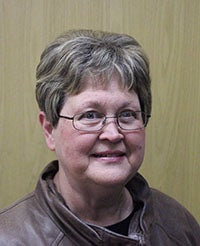Grow plants that attract wildlife to the gardens
Published 9:00 am Sunday, January 18, 2015
Serendipity Gardens by Carol Hegel Lang
Now that we are thinking about spring only two months away, we should also think about what we can add to our gardens to attract wildlife. The three things they need are food, water and shelter, so I thought this time we would talk about plants that attract them to your gardens.

A tiger swallowtail butterfly sips nectar on a coneflower and rudbeckia are in the background. Both plants attract butterflies. – Carol Hegel Lang/Albert Lea Tribune
Many of the seed catalogs will have a key that tells not only the growing requirements, but many will also tell you if they attract birds, bees and butterflies — which can be very helpful in planning additions to your gardens. Also, many of them will tell you if they are not attractive to deer for those who have problems with them eating your plants.
“Beautiful and graceful, varied and enchanting, small but approachable, butterflies lead you to the sunny side of life. And everyone deserves a little sunshine.” — Jeffrey Glassberg.
Doesn’t this quote make you want to have more flowers in your garden to attract the butterflies? Many of the flowers that I am going to give you will also attract hummingbirds and bees but they are also very attractive to butterflies. I am only going to list those that I have growing in my own gardens so don’t think these are the only ones. My list includes the following: zinnia, cosmos, agastache, celosia, coreopsis, marigolds, rudbeckia, verbena bonariensis, calibrachoa, butterfly weed, Joe-pye weed, coneflower, delphinium, hollyhock, malva and globe thistle.
We have seen the disappearance of bees over the past few years, so it is very important that we include flowers that will attract them. We also need to be aware that certain chemicals will kill our bees, so you want to investigate where they are being grown to be sure there are no GMOs, treated seeds or neonicotinoids used in growing them. Don’t be afraid to ask when you buy plants or seeds — it is our responsibility to protect them. My list for bees starts with alyssum as this gem is always covered with bees. My favorite is the hybrid snow princess that does not produce seed so it blooms profusely all season. The rest of the list includes the following: sedum, liatris, heliotrope, Ammi majus, both Shirley and California poppies, cleome, cornflowers, larkspur, snapdragon, tithonia, baptisa, balsam and catmint.
“Have you ever observed a hummingbird moving about in an aerial dance among the flowers — a living prismatic gem… it is a creature of such fairy-like loveliness as to mock all description.” — W. H. Hudson.
Who doesn’t love to watch those hummingbirds as they zip around the gardens like little helicopters? Well, you can invite them into your gardens all summer long if you not only have the sugar-water feeders, but flowers that have a tubular red bloom. My number one plant choice is fuchsia, which has kept the hummers in my gardens from May all the way through September. Here are a few other plants that they love: four o’clocks, nicotiana, salvia, sunflower (these are for goldfinch), cardinal climber, cypress vine, morning glories, petunia, lantana, phlox and bee balm.
Attracting wildlife to your gardens will also benefit your vegetable gardens as it will bring in beneficial insects. For me having all of this activity in my gardens is what gardening is all about. The birds that visit all year long bring me so much happiness. During spring migration the gardens are so busy with all of the different birds visiting the feeders that I have hanging, I can hardly keep up watching everything.
Henry David Thoreau stated, “I believe that there is a subtle magnetism in Nature, which if we unconsciously yield to it, will direct us aright.” How true this statement is for me. Nature really has influenced my style of gardening to accommodate them, not only into my gardens, but also my life. My proudest accomplishment as a gardener was when the gardens were certified as a backyard wildlife habitat by the National Wildlife Federation. Little by little I added more places for wildlife to live safely, adding water was so easy and didn’t have to be expensive as so many things you have in your house make great bird baths. Why not add some of these plants to your gardens this spring and see what visits them?
Carol Hegel Lang is a green thumb residing in Albert Lea. Her column appears weekly. Email her at carolhegellang@gmail.com.





